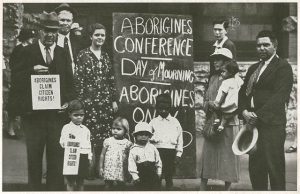40 Australian Indigenous Rights Movement by James Nowland
Protection Act: Source analysis

Aborigines day of mourning by State Library of New South Wales, Public Domain
| Curriculum Context | ACT Senior Curriculum (ACT Board of Senior Secondary Studies, ND). |
| Historical Context | Modern History: Change in the 20th century (ACT Board of Senior Secondary Studies, ND). |
| Historical Thinking Concepts | Continuity and change
Significance |
| Learning Intentions | Students will begin to understand the key features of the Indigenous rights movement and its significance to 20th century change in Australia.
Students will critically analyse a historical source to begin to understand indigenous human rights abuses within Australia as well as consider Aboriginal perspectives. |
Activity
Part 1
a) Source Analysis (Protection Act)
Using this link NSW Protection Act 1909, analyse the New South Wales Aboriginal protection act and answer the following questions.
Analysis Questions:
Contextual Understanding:
- What historical events or social conditions led to the introduction of the New South Wales 1909 Aboriginal Protection Act?
- How did the Act aim to regulate and control the lives of Indigenous Australians?
Purpose
- What was the primary purpose of the 1909 Aboriginal Protection Act in New South Wales?
- How did the Act’s provisions affect the rights and freedoms of Aboriginal individuals and communities?
Implications:
- How did the 1909 Act change the legal status and rights of Indigenous Australians in New South Wales?
- In what ways did the Act reflect prevailing attitudes and beliefs about Aboriginal people during that time?
Consequences:
- How might the 1909 Aboriginal Protection Act have influenced the trajectory of Indigenous rights and relationships with the Australian government and society over the following decades?
b) Stolen Generations Testimonies
Choose two testimonies from The Stolen Generations Testimonies Foundation pertaining to the stolen generations. After you have listened and taken some notes, respond to the questions below.
- What emotions and experiences do they convey, and how do these stories contribute to our understanding of the impacts of forced removal policies on Indigenous individuals and communities?
- How did these policies violate the rights and cultural heritage of Indigenous people? What were the intended and unintended consequences?
- What common themes emerge from their testimonies, and how do their stories shed light on the broader scope of Indigenous rights violations?
- How can these stories contribute to fostering empathy, understanding, and a more inclusive society that respects Indigenous rights and cultures?
Compare your answers with the person next to you and discuss which UN human rights are being abused.
Part 2
Read the article below and respond to the questions.
The Birth of Modern First Nations Protest
- What is the main focus or central theme of the article in relation to the Day of Mourning, and how does it contribute to our understanding of the historical significance of this event in Australian Indigenous history?
- Who are the primary authors or contributors of the article, and what perspectives or expertise do they bring to the discussion of the Day of Mourning?
- How does the article describe the events and context leading up to the Day of Mourning in 1938? What specific grievances and demands were expressed by Indigenous Australians during this event?
- Analyse the portrayal of the reactions from government officials, non-Indigenous Australians, and the media in response to the Day of Mourning. How do these reactions reflect the prevailing attitudes and power dynamics of the time?
- Consider the broader historical and social context in which the Day of Mourning took place. How did other significant events, policies, or movements (such as the Stolen Generations, land rights activism, or racial discrimination) intersect with the Day of Mourning and influence its goals and outcomes.
References
ACT Board of Senior Secondary Studies (BSSS). (n.d.). Modern history A-T-M. https://www.bsss.act.edu.au/act_senior_secondary_system/curriculum/bsss_courses/humanities_and_social_sciences/modern_history_a-t-m
Butler, D. (2023, January 10th). EXPLAINER: Day of Mourning, the birth of modern First Nations protest. NITV News. https://www.sbs.com.au/nitv/article/explainer-day-of-mourning-the-birth-of-modern-first-nations-protest/j6ccrqkgb
Hogan, M. (n.d.). Stolen Generations’ Testimonies. https://www.stolengenerationstestimonies.com/
NSW Government. (1909). Act no. 25 Aborigines Protection. https://legislation.nsw.gov.au/view/pdf/asmade/act-1909-25
United Nations. (n.d.). Universal Declaration of Human Rights. https://www.un.org/en/about-us/universal-declaration-of-human-rights

